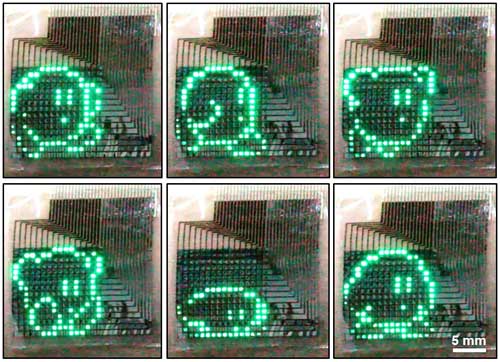| Posted: Aug 29, 2017 | |
Wearable quantum dot display as electronic skin |
|
| (Nanowerk Spotlight) Nanotechnology research has led to the development of numerous ultrathin displays based on various inorganic, polymer, and organic materials. For instance, transparent oxide thin-film transistors have been fabricated for wearable displays or ultrathin organic photonic skins that could serve as electronic skin sensors and displays. | |
| Although there has been rapid development in wearable skin-like sensors and electronics, relatively rigid and bulky chips are still required for a fully integrated system. | |
| In new work, a research team in South Korea has developed an ultrathin wearable display based on inorganic nanoparticles – quantum dots – which are one of the most promising optoelectronic materials. | |
| Reporting their findings in Advanced Materials ("Ultrathin Quantum Dot Display Integrated with Wearable Electronics"), a team led by Professor Dae-Hyeong Kim and his Translational Flextronics Group at Seoul National University, demonstrated a passive matrix quantum dot light-emitting diode (QLED) display fully integrated with flexible electronics. | |
 |
|
| Photographs of sequential frames showing a short movie of a jumping cartoon character rendered in the ultrathin display against the skin. (Image: Translational Flextronics Group, Seoul National University) (click on image to enlarge) | |
| The group has been working on wearable displays and sensors for some time now and we previously reported on their stretchable carbon nanotube electronics. | |
| "The most important point in this work is that we realized the visualization of meaningful information such as images, recorded healthcare data, and other messages using an ultrathin display," Kim tells Nanowerk. "Our ultrathin and ultrasoft QLED array can be conformally laminated on human skin. It will provide many opportunities in the industry also." | |
| This work shows the state of the art of engineering in wearable display technology. The fabricated ultrathin (∼5.5 µm) red, green, and blue (RGB) QLED displays utilize a passive matrix structure to address individual pixels. The display allows for facile deformation and conformal integration with the skin, thereby reducing discomfort and preventing its mechanical failures. | |
| The paper also provides new scientific findings regarding quantum dots' structure. The researchers tried to optimize the shell thickness of the quantum dots for improving the luminescence performance. Consequently, they found that quantum dots, which have 2 nm-thicker shell structure compared to conventional quantum dots, show enormous improvement in brightness and luminous efficacy. | |
| The improved performance allowed the low-voltage (4∼7 V) operation of the developed ultrathin quantum dot display. | |
| Kim and his team anticipate that their work triggers the development of integrated platform composed of wearable sensors/actuators and display. Ultrathin wearable devices developed so far only focused on the sensitivity and reliability in sensing. If the measured data can be shown to user directly on the skin-attached device itself, more intuitive communication between the user and the device would be possible. | |
| Video of an ultrathin 16x16 QLED display of an animated cartoon character attached to human skin. (Video: Translational Flextronics Group, Seoul National University) | |
| Next stages of this work will be the development of a skin-attachable display that is operated in the active-matrix mode for realization of the higher resolution and larger display. | |
| "Furthermore" adds Kim, "ultimately integrated sensors and circuitry should be even more miniaturized and mechanically more compatible with human skin for fully integrated wearable devices and we need to work on that, too." | |
| In addition, the scientists will develop a higher resolution version of the ultrathin wearable display implemented with the active matrix operation technology. For that, they need to integrate a high-resolution ultrathin transistor array as well as improve the performance of QLEDs. | |
| "From a system point of view, the wearable skin-like electronics should be fully integrated and operated as a stand-alone device," Kim concludes. "Towards that goal, we need to further address various challenges, such as battery size, ultrathin processors, wireless communication modules, and production cost." | |
 By
Michael
Berger
– Michael is author of three books by the Royal Society of Chemistry:
Nano-Society: Pushing the Boundaries of Technology,
Nanotechnology: The Future is Tiny, and
Nanoengineering: The Skills and Tools Making Technology Invisible
Copyright ©
Nanowerk LLC
By
Michael
Berger
– Michael is author of three books by the Royal Society of Chemistry:
Nano-Society: Pushing the Boundaries of Technology,
Nanotechnology: The Future is Tiny, and
Nanoengineering: The Skills and Tools Making Technology Invisible
Copyright ©
Nanowerk LLC
|
|
|
Become a Spotlight guest author! Join our large and growing group of guest contributors. Have you just published a scientific paper or have other exciting developments to share with the nanotechnology community? Here is how to publish on nanowerk.com. |
|
